Top 12 Groundhog Days
None
It’s all just a little bit of history repeating in our rundown of the best never-ending days on TV and film
The characters in every one of these time loop tales – whether by magic, technology or inexplicable circumstance – are forced to relive the same events over and over again until the cycle is broken, often learning a few things about themselves along the way. It’s a premise which powers Duncan Jones’ latest film Source Code , out on DVD and Blu-ray today. If you haven’t heard, it’s rather good , so to celebrate we’re counting down our other favourite trial and error tales from TV and film.
By Jordan Farley
12. 12:01
1990 (short film)

Whoa, déjà Vu: Myron Castleman ( RoboCop ’s Kurtwood Smith) is forced to endlessly cross over the same stretch of road, eat carrot sticks in the park and deal with the most irritating secretary in the world. Grim.
How is the loop broken? It isn’t, not in the short film at least where Castleman tries to top himself after learning he’s doomed to repeat the same 59 minutes over and over again, only to wake up back where he started.
Weekly digests, tales from the communities you love, and more
Based on a 1973 Richard A Lupoff short story, the austere 30-minute Showtime channel short 12:01 is considered the first “groundhog day” type tale – so much so that the makers brought legal action against the team behind Groundhog Day , before later dropping the case. The similarities are more evident with the feature length TV movie made three years later, however – another adaptation of the same short story which features a much more upbeat ending.
12:01 , you see, is pure Twilight Zone with everyday bub Castleman the only person aware that the entire world is eternally repeating the same lunch hour from 12:01 to 13:00. Despite contacting a scientist who predicted the event, Castleman discovers he’s totally powerless to change his fate, even by painting a window with his brains. Bleak just doesn’t cut it.
11. Farscape “Back And Back And Back To The Future”
2010 (Season 2, Episode 18)
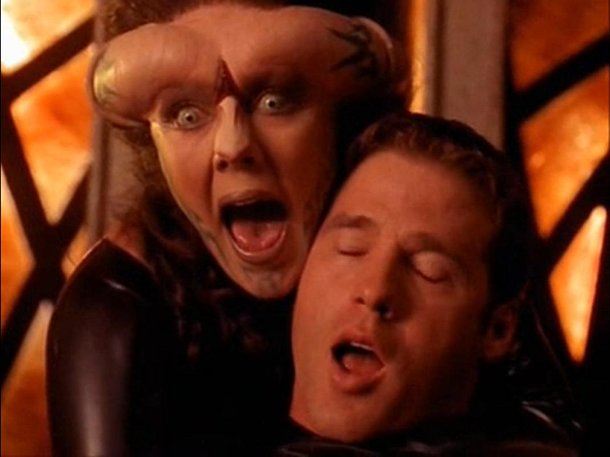
Whoa, déjà vu: An alien scientist called Matala kills crew members left, right and centre and Crichton repeatedly breaks Zhaan’s mask.
How is the loop broken? They Starburst away, destroying Matala and the disguised Scorvian vessel.
“Back And Back And Back To The Future” is slightly different to the other entries on this list in the fact that Crichton experiences brief visions of the future, which he can live through and alter, as opposed to a repeating time loop. His visions of the future are frequently quite shocking (including the sudden deaths of most crew members), but none more so than his first vision – a twisted sexual fantasy with Matala. Creepy.
10. Xena: Warrior Princess “Been There, Done That”
2010 (Season 2, Episode 18)
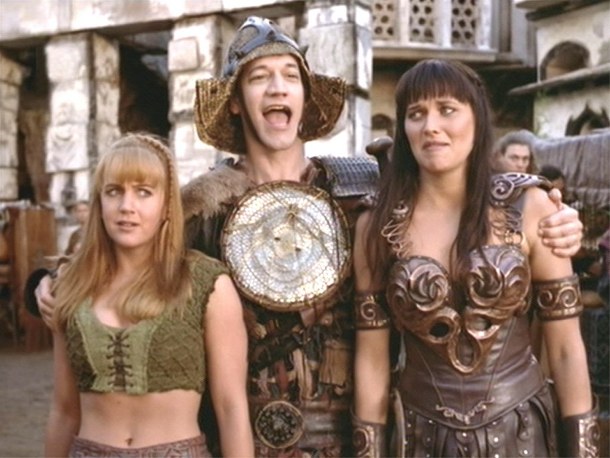
Whoa, déjà vu: The rooster crows, Joxer walks in, the horse shoe falls, Joxer drops his goose eggs… and lots of people die.
How is the loop broken? Xena makes a miracle shot, bouncing her chakram all round town, and breaking the vial of nightsbane poison before it can be used by the cupid-cursed lover.
Often, the best thing about time loop tales such as “Been There, Done That” is seeing things which would never usually happen in the normal course of a season. Here, for example, Joxer getting a chakram through his ribcage. Is it wrong that we let out a little cheer?
Gratuitous murders aside this is one of the show’s better episodes, with a mystery that’s pure Romeo And Juliet and a nice mix of typically goofy humour and high drama. Xena’s method for destroying the vial, in particular, is pleasingly silly. Fun fact: keep a close eye on the Inn’s sign for hints at what’s to come.
9. Eureka “I Do Over”
2009 (Season 3, Episode 4)

Whoa, déjà vu: Stark and Allison’s wedding, Carter’s early morning shower, Lexi’s arrival, staff layoffs at Global Dynamics, lunch in Café Diem and more.
How is the loop broken? Stark sacrifices his life by manually synchronising the clocks and activating the proton accelerator.
In Eureka ’s technology-gone-mad town it was only a matter of time before one of those pesky inventions went awry and Sherriff Carter found himself stuck in his own groundhog day. Although “I Do Over” doesn’t do a great deal different with the time loop trope, it does permanently bump off a character – rare for these types of episodes – and delivers a hefty emotional gut punch.
As if making Carter watch the love of his life repeatedly walk down the aisle to marry a man he loathes wasn’t bad enough, GD big shot Stark willingly sacrifices his life to save the world. And on his wedding day too. Sniff.
8. Angel “Time Bomb”
2004 (Season 5, Episode 19)

Whoa, déjà vu: Ilyria re-lives several key moments as she becomes unstuck in time, including a massacre in the training room and Gunn’s rescue from his chamber of torment.
How is the loop broken? Wesley saps Illyria’s uncontrollable excess energy using a Mutari Generator.
Written by the mighty Ben Edlund, “Time Bomb” features a show-stopping set-piece where Illyria butchers Spike, Wesley, Lorne and Angel in mere seconds. Fortunately, this being a groundhog day story, Illyria’s actions are undone by the inability of her physical vessel (Fred) to contain her dimension-hopping power.
The complex structure means it’s the kind of episode that works even better the second time round as small moments take on an unrealised significance and you’re not continually playing catch-up. With just three episodes left after “Time Bomb” until the series finale Edlund even manages to find time to cram in a few crucial arc elements, like Illyria telling Angel “the only way to win a war is to serve no master but your own ambition,” (the importance of which would only become apparent in a later episode) and Wesley finally accepting he can no longer save Fred.
7. The X-Files “Monday”
1999 (Season 6, Episode 13)
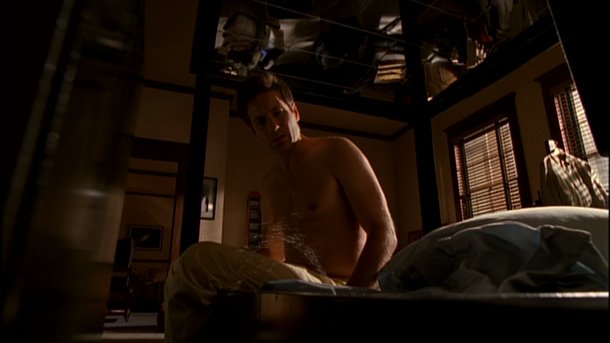
Whoa, déjà vu: A broken alarm clock, Mulder’s leaky water bed and a bank that goes boom.
How is the loop broken? Pam, the woman experiencing the time loop, is killed after trying to intervene in her boyfriend’s bank robbery.
As far as twists go, killing off your two lead characters in an explosion halfway through a season would have been a bit of a shocker. There’s nothing to worry about though, because after a quick break for the titles, turns out Mulder and Scully are alive and kicking, but far from fine with the pair stuck in a woman’s endlessly repeating time loop.
With Mulder oblivious to what’s going on around him, the episode finds humour in his repeated anger at waking up to find his water bed has sprung a leak. The bank is where most of the interesting alternate scenarios play out as Mulder and Scully go through a range of ways to stop the trench coat terrorist blowing himself up. It ends on a neat piece of mis-direction, tricking us into thinking the day has reset itself yet again, only for Mulder to rise from his couch instead of a soggy bed. Fun fact: The episode was co-written by Breaking Bad showrunner Vince Gilligan, who claims The Twilight Zone episode “Shadow Play” as an influence.
6. Buffy The Vampire Slayer “Life Serial”
2001 (Season 6, Episode 5)

Whoa, déjà vu: Buffy must repeatedly serve a tricky customer looking to buy a bothersome mummy hand in the Magic Box
How is the loop broken? She successfully makes the sale by ordering another hand for delivery instead of capturing the one in the basement.
In typical Buffy fashion, a trope which most other shows build an entire episode round is merely one small part of a much bigger whole. And it’s brilliant.
The nerdy trio are out to test Buffy’s limits, also using magic to make time slow to a crawl for her, and summoning demons to fight her. But Jonathan’s test is a little more devious – trapping Buffy in a time loop where her only escape is to satisfy a customer. She fails continually, even ripping the glasses out of Giles’ hands and smashing them to pieces at one point, before finally realising there’s a much more left-field solution to her problem.
It’s an inspired, downright hilarious sketch, and one that’s not ignorant of its influences either with Andrew and Warren directly referencing “the episode of TNG where the Enterprise kept blowing up” and “that X-Files where the bank kept exploding.” But even this doesn’t stop it feeling fresher than most that came before.
5. Fringe “White Tulip”
2010 (Season 2, Episode 18)
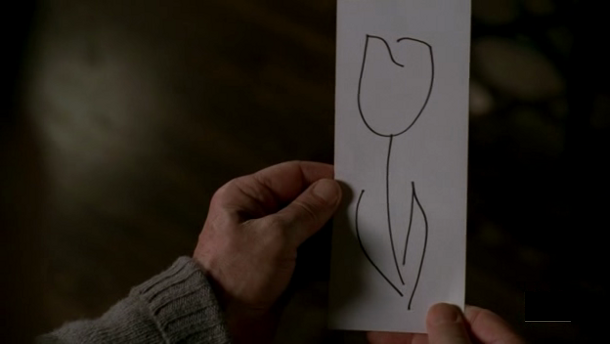
Whoa, déjà vu: The deaths of a train carriage full of passengers, Walter writing a letter to Peter and the raid on Alistair Peck’s apartment.
How is the loop broken? Time traveller Peck succeeds in jumping to the past and is able to join his wife in her car seconds before a fatal collision.
Fringe hit its stride in the second half of season two, and “White Tulip” is arguably the show’s best episode. RoboCop (aka Peter Weller) guests as a scientist, Alistair Peck, whose own tragic life mirrors Walter’s – he’s pushing the boundaries and breaking the laws of nature to reclaim something the universe has taken from him.
It’s smartly structured, exciting and full of squirm-inducing body horror. Weller is note perfect as the inconsolable, but brilliant scientist willing to do whatever it takes to be reunited with his wife; and despite “killing” a train full of passengers, at no point is he a villain. His poignant story is just as morally dubious as Walter’s (who is agonising over how to tell Peter the truth about where he’s from), which also unfolds in the background, until the two come together in a heartbreaking final scene. It’s stunningly shot to boot – particularly the moment where all sound bar the score drops out as Peck is finally reunited with the love of his life. If you didn’t well up at least once you have no soul.
4. Groundhog Day
1993 (Feature film)
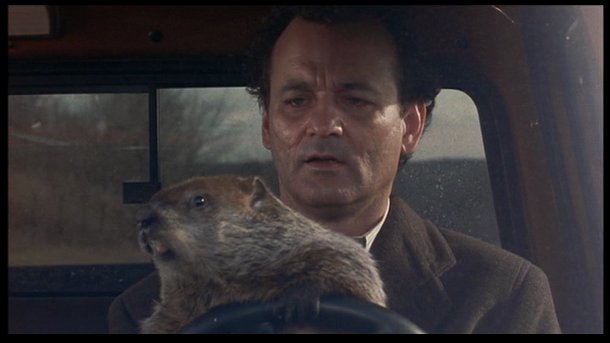
Whoa, déjà vu: “I Got You Babe” by Sonny and Cher, Punxsutawney Phil, nasally Ned Ryerson and much more.
How is the loop broken? Self-centred meteorologist Phil Connors (Bill Murray) becomes a better person by helping the townsfolk and wins over his news producer Rita. That or sex is a cure-all for time-based phenomenon.
It might not have been the first, but there’s a reason why the phrase “groundhog day” has become synonymous with this type of story. In the film Murray (still at the height of his comedic powers) finds himself endlessly reliving 2 February in a snow-swept Pennsylvania town, where he’s reporting from the annual Groundhog Day ceremony.
With ample time on his hands Connors learns to play the piano and is even able to commit the townsfolks’ daily routines to memory. The real fun starts when he realises in a time loop there are no consequences to your actions, leading Connors to try his hand at everything from punching that guy he just can’t stand to kidnapping the beloved town gofer and driving him off the edge of a cliff. It’s got heart, humour and the smartest high-concept script this side of Back To The Future .
3. Star Trek: The Next Generation: “Cause And Effect”
1992 (Season 5, Episode 18)
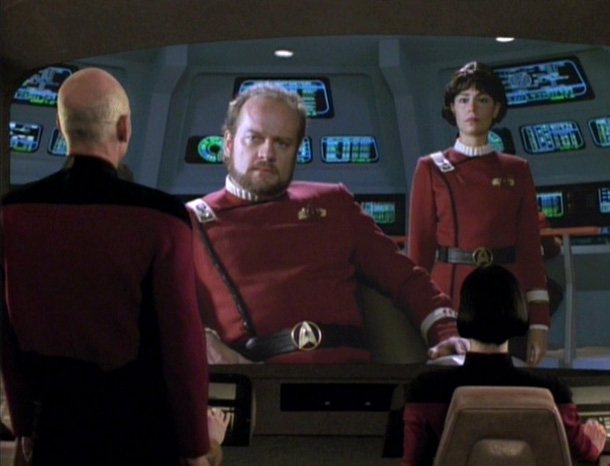
Whoa, déjà vu: An endlessly repeating Poker game , whispers in the night, a broken cup and an explosive collision with another starship.
How is the loop broken? Data is able to decipher messages sent from previous iterations of himself and institute Riker’s plan instead of his own, narrowly avoiding yet another collision with the USS Bozeman.
“Cause And Effect” is slightly different to the other entries in this list as the characters are all aware (to a lesser or greater degree) that something isn’t quite right, but instead of a perfect memory of previous loops those affected experience déjà vu to the events going on around them; Dr Crusher in particular.
Turns out the time loops are being caused by tachyon distortions near a space-time anomaly (that old chestnut) which Data is able to use to send a message to his future self. Kelsey Grammar cameos as the captain of the USS Bozeman, a ship which has been missing for more than 80 years, and it’s also the first episode to feature the fan-favourite poker scenes.
2. Supernatural “Mystery Spot”
2008 (Season 3, Episode 11)
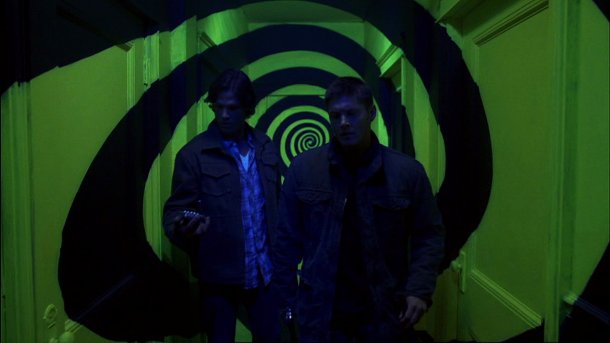
Whoa, déjà vu: “Heat Of The Moment” by Asia and the many, many deaths of Dean Winchester.
How is the loop broken? The Trickster allows Sam to return to his normal timeline having learnt a valuable lesson.
For an episode which features one of the Winchesters dying repeatedly, in some quite grisly ways, “Mystery Spot” is arguably the funniest 40 minutes of TV that Supernatural has ever put out. The comedy couldn’t be much darker, with Sam snapping out of bed to an obnoxious wake-up call every time Dean dies in increasingly outlandish fashion. He gets blasted with a shotgun, hit by a car, flattened by a piano, slips in the shower, chokes on a sausage, gets electrocuted and scoffs down on a taco that tastes “funny”. And that’s just the first 20 loops.
Turns out the Trickster is behind the madness – he’s out to teach Sam that his only weakness is his brother – a neat twist which gives the episode weight beyond the gimmick. We’re also given an early insight into the kind of badass hunter Sam will later become. One question though, what does Sam do with that ruler in the morning?
1. Stargate SG-1 “Window Of Opportunity”
2000 (Season 4, Episode 6)

Whoa, déjà vu: Fruit loops, Teal’c repeatedly getting hit in the face by a door, the briefing room, the premature return of SG-12, deciphering Ancient tablets in Jackson’s quarters... the list goes on.
How is the loop broken? O’Neil is able to talk Malikai into deactivating the Ancient device.
“Window Of Opportunity” is widely regarded as one of the best episodes of SG-1 , and in a series with more than 200 episodes that’s nothing to be sniffed at. It’s a perfectly formed bubble of time loop storytelling. The fact O’Neil and Teal’c, the people worst suited to solve the team’s predicament, are the only members of SG-1 to realise they’re continually being sent back through time is a touch of genius, and the source of much of the episode’s humour.
In fact it’s also one of the funniest episode’s in the show’s history with Richard Dean Anderson at his deadpan best and even Teal’c getting the odd moment to let loose, hitting a billion mile drive into the Stargate. As well as humour it’s also got a fair amount of emotional complexity – the antagonist’s plight in particular is full of pathos, making it easy to empathise with his misguided actions. Even if you’ve never watched an episode of SG-1 , we recommend it.

I'm the Managing Editor, Entertainment here at GamesRadar+, overseeing the site's film and TV coverage. In a previous life as a print dinosaur, I was the Deputy Editor of Total Film magazine, and the news editor at SFX magazine. Fun fact: two of my favourite films released on the same day - Blade Runner and The Thing.


